Training and Development Needs Analysis Report for Woolworths
VerifiedAdded on 2023/06/06
|11
|2751
|175
Report
AI Summary
This report presents a thorough analysis of Woolworths' training and development needs. It begins with an overview of Woolworths' background, mission, vision, and corporate goals, followed by an examination of its company culture. The core of the report focuses on a training needs analysis, highlighting the importance of such programs in the competitive retail environment and identifying the need to adapt to changing customer demands. A skills gap analysis is conducted, comparing current and desired skill levels across various competencies. The report then details the selection of appropriate assessment methods, including questionnaires and document reviews, and outlines the needs assessment process. Furthermore, it discusses the expected outcomes of a well-planned training program, such as improved employee performance and reduced costs. Conversely, the report also addresses the negative consequences of an improperly planned needs assessment, emphasizing the importance of a comprehensive approach to identify and address performance gaps within the organization. The report concludes by underscoring the critical role of needs assessment in determining the necessity and effectiveness of training and development programs within Woolworths.
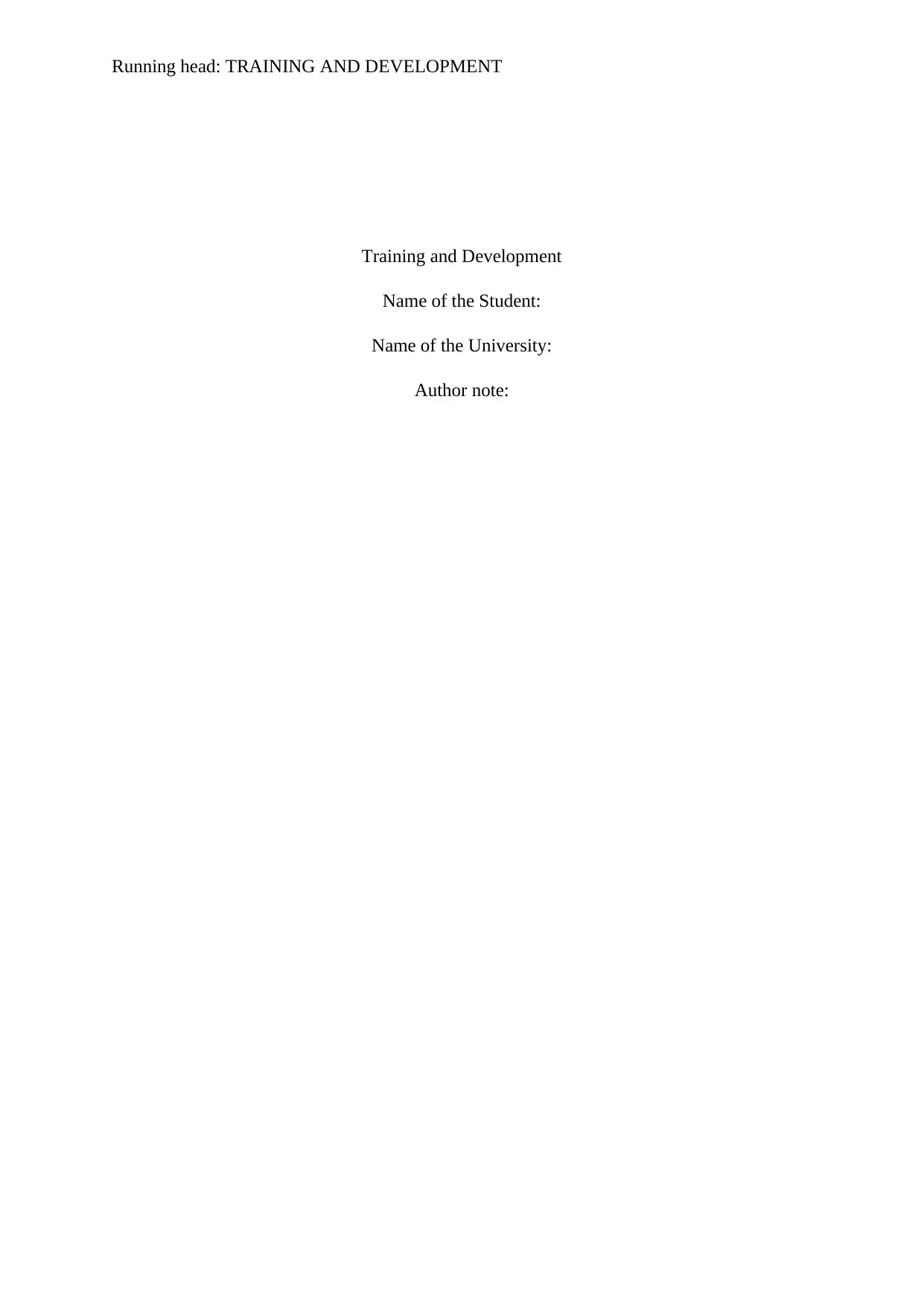
Running head: TRAINING AND DEVELOPMENT
Training and Development
Name of the Student:
Name of the University:
Author note:
Training and Development
Name of the Student:
Name of the University:
Author note:
Paraphrase This Document
Need a fresh take? Get an instant paraphrase of this document with our AI Paraphraser
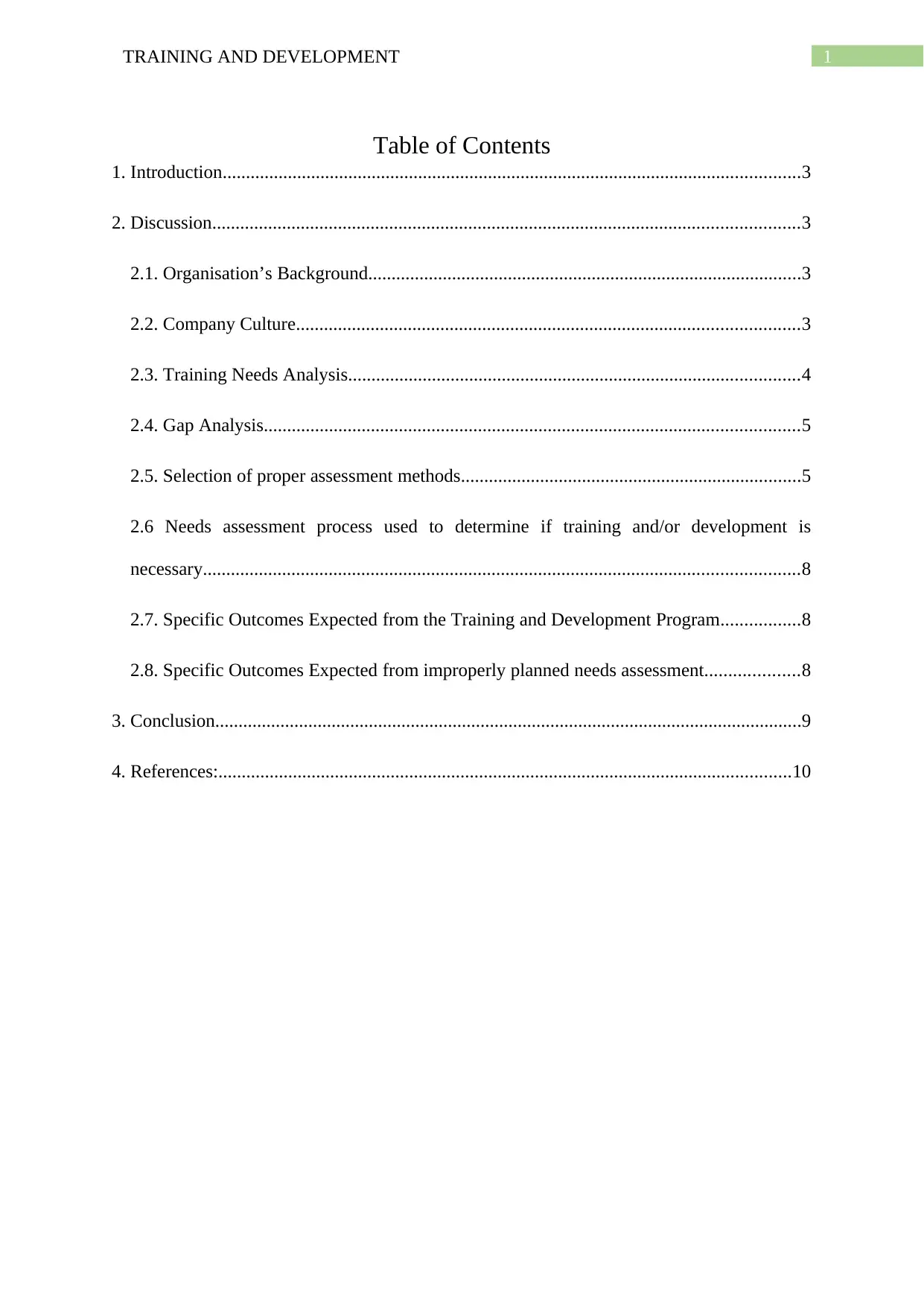
1TRAINING AND DEVELOPMENT
Table of Contents
1. Introduction............................................................................................................................3
2. Discussion..............................................................................................................................3
2.1. Organisation’s Background.............................................................................................3
2.2. Company Culture............................................................................................................3
2.3. Training Needs Analysis.................................................................................................4
2.4. Gap Analysis...................................................................................................................5
2.5. Selection of proper assessment methods.........................................................................5
2.6 Needs assessment process used to determine if training and/or development is
necessary................................................................................................................................8
2.7. Specific Outcomes Expected from the Training and Development Program.................8
2.8. Specific Outcomes Expected from improperly planned needs assessment....................8
3. Conclusion..............................................................................................................................9
4. References:...........................................................................................................................10
Table of Contents
1. Introduction............................................................................................................................3
2. Discussion..............................................................................................................................3
2.1. Organisation’s Background.............................................................................................3
2.2. Company Culture............................................................................................................3
2.3. Training Needs Analysis.................................................................................................4
2.4. Gap Analysis...................................................................................................................5
2.5. Selection of proper assessment methods.........................................................................5
2.6 Needs assessment process used to determine if training and/or development is
necessary................................................................................................................................8
2.7. Specific Outcomes Expected from the Training and Development Program.................8
2.8. Specific Outcomes Expected from improperly planned needs assessment....................8
3. Conclusion..............................................................................................................................9
4. References:...........................................................................................................................10
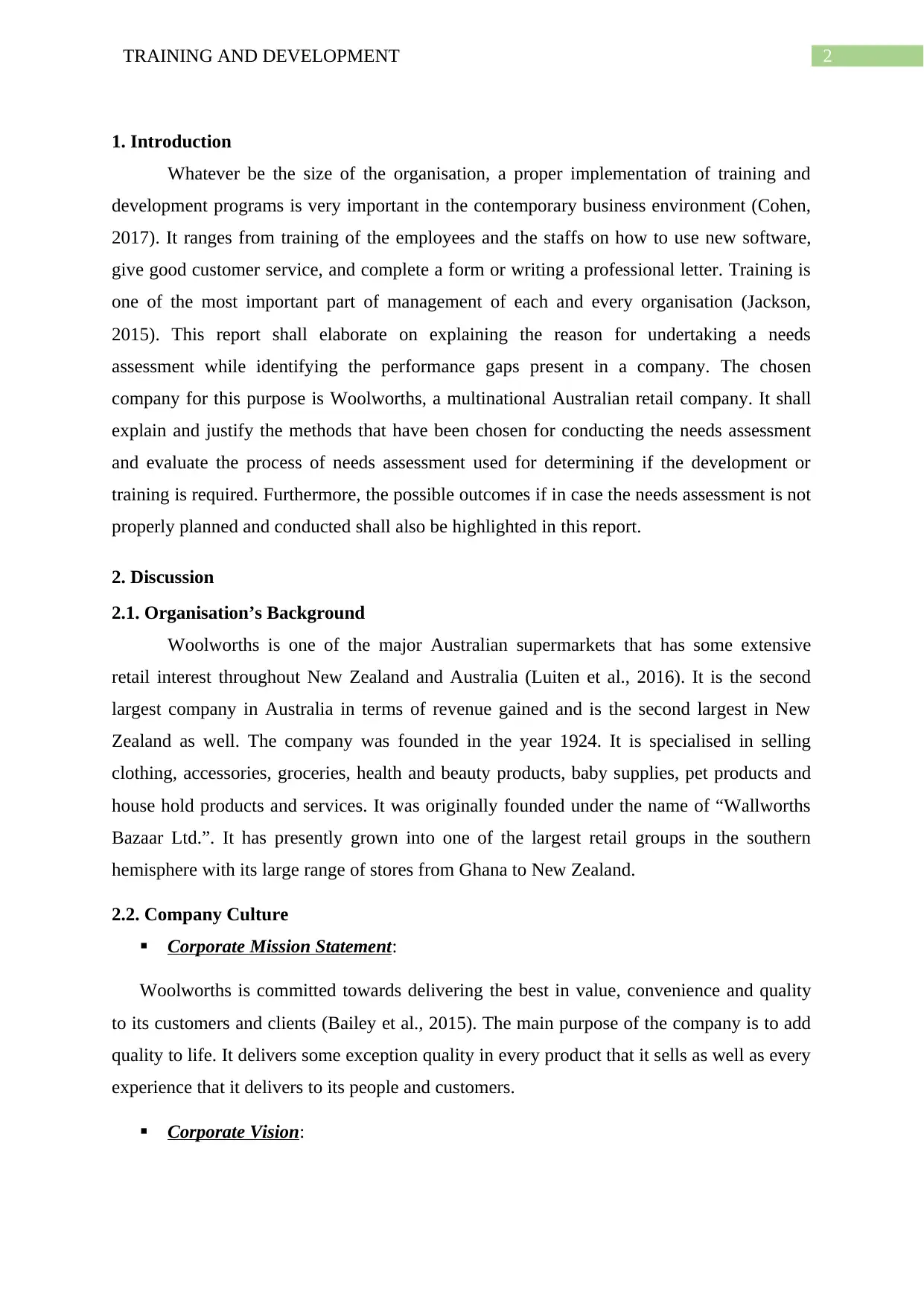
2TRAINING AND DEVELOPMENT
1. Introduction
Whatever be the size of the organisation, a proper implementation of training and
development programs is very important in the contemporary business environment (Cohen,
2017). It ranges from training of the employees and the staffs on how to use new software,
give good customer service, and complete a form or writing a professional letter. Training is
one of the most important part of management of each and every organisation (Jackson,
2015). This report shall elaborate on explaining the reason for undertaking a needs
assessment while identifying the performance gaps present in a company. The chosen
company for this purpose is Woolworths, a multinational Australian retail company. It shall
explain and justify the methods that have been chosen for conducting the needs assessment
and evaluate the process of needs assessment used for determining if the development or
training is required. Furthermore, the possible outcomes if in case the needs assessment is not
properly planned and conducted shall also be highlighted in this report.
2. Discussion
2.1. Organisation’s Background
Woolworths is one of the major Australian supermarkets that has some extensive
retail interest throughout New Zealand and Australia (Luiten et al., 2016). It is the second
largest company in Australia in terms of revenue gained and is the second largest in New
Zealand as well. The company was founded in the year 1924. It is specialised in selling
clothing, accessories, groceries, health and beauty products, baby supplies, pet products and
house hold products and services. It was originally founded under the name of “Wallworths
Bazaar Ltd.”. It has presently grown into one of the largest retail groups in the southern
hemisphere with its large range of stores from Ghana to New Zealand.
2.2. Company Culture
Corporate Mission Statement:
Woolworths is committed towards delivering the best in value, convenience and quality
to its customers and clients (Bailey et al., 2015). The main purpose of the company is to add
quality to life. It delivers some exception quality in every product that it sells as well as every
experience that it delivers to its people and customers.
Corporate Vision:
1. Introduction
Whatever be the size of the organisation, a proper implementation of training and
development programs is very important in the contemporary business environment (Cohen,
2017). It ranges from training of the employees and the staffs on how to use new software,
give good customer service, and complete a form or writing a professional letter. Training is
one of the most important part of management of each and every organisation (Jackson,
2015). This report shall elaborate on explaining the reason for undertaking a needs
assessment while identifying the performance gaps present in a company. The chosen
company for this purpose is Woolworths, a multinational Australian retail company. It shall
explain and justify the methods that have been chosen for conducting the needs assessment
and evaluate the process of needs assessment used for determining if the development or
training is required. Furthermore, the possible outcomes if in case the needs assessment is not
properly planned and conducted shall also be highlighted in this report.
2. Discussion
2.1. Organisation’s Background
Woolworths is one of the major Australian supermarkets that has some extensive
retail interest throughout New Zealand and Australia (Luiten et al., 2016). It is the second
largest company in Australia in terms of revenue gained and is the second largest in New
Zealand as well. The company was founded in the year 1924. It is specialised in selling
clothing, accessories, groceries, health and beauty products, baby supplies, pet products and
house hold products and services. It was originally founded under the name of “Wallworths
Bazaar Ltd.”. It has presently grown into one of the largest retail groups in the southern
hemisphere with its large range of stores from Ghana to New Zealand.
2.2. Company Culture
Corporate Mission Statement:
Woolworths is committed towards delivering the best in value, convenience and quality
to its customers and clients (Bailey et al., 2015). The main purpose of the company is to add
quality to life. It delivers some exception quality in every product that it sells as well as every
experience that it delivers to its people and customers.
Corporate Vision:
⊘ This is a preview!⊘
Do you want full access?
Subscribe today to unlock all pages.

Trusted by 1+ million students worldwide
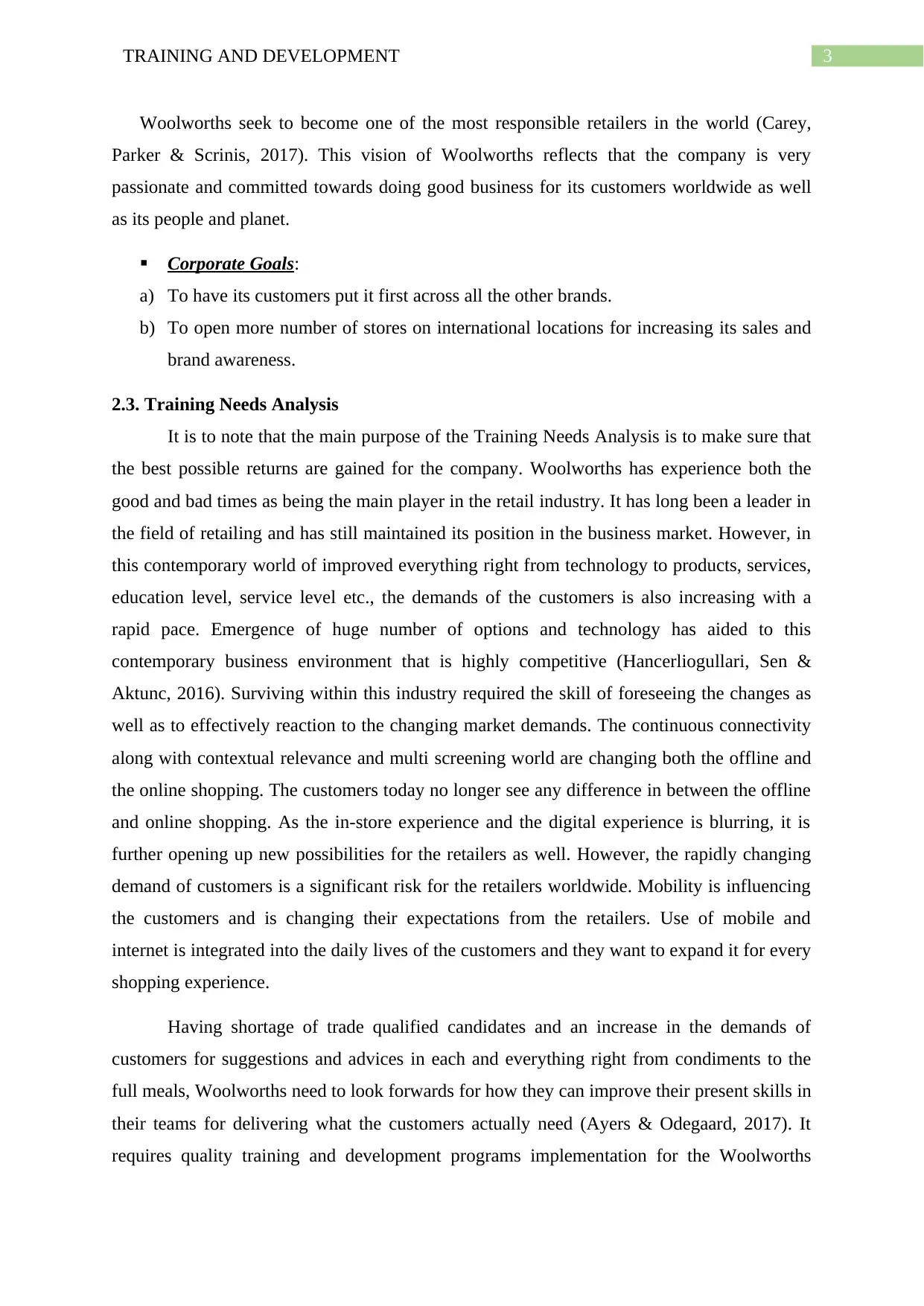
3TRAINING AND DEVELOPMENT
Woolworths seek to become one of the most responsible retailers in the world (Carey,
Parker & Scrinis, 2017). This vision of Woolworths reflects that the company is very
passionate and committed towards doing good business for its customers worldwide as well
as its people and planet.
Corporate Goals:
a) To have its customers put it first across all the other brands.
b) To open more number of stores on international locations for increasing its sales and
brand awareness.
2.3. Training Needs Analysis
It is to note that the main purpose of the Training Needs Analysis is to make sure that
the best possible returns are gained for the company. Woolworths has experience both the
good and bad times as being the main player in the retail industry. It has long been a leader in
the field of retailing and has still maintained its position in the business market. However, in
this contemporary world of improved everything right from technology to products, services,
education level, service level etc., the demands of the customers is also increasing with a
rapid pace. Emergence of huge number of options and technology has aided to this
contemporary business environment that is highly competitive (Hancerliogullari, Sen &
Aktunc, 2016). Surviving within this industry required the skill of foreseeing the changes as
well as to effectively reaction to the changing market demands. The continuous connectivity
along with contextual relevance and multi screening world are changing both the offline and
the online shopping. The customers today no longer see any difference in between the offline
and online shopping. As the in-store experience and the digital experience is blurring, it is
further opening up new possibilities for the retailers as well. However, the rapidly changing
demand of customers is a significant risk for the retailers worldwide. Mobility is influencing
the customers and is changing their expectations from the retailers. Use of mobile and
internet is integrated into the daily lives of the customers and they want to expand it for every
shopping experience.
Having shortage of trade qualified candidates and an increase in the demands of
customers for suggestions and advices in each and everything right from condiments to the
full meals, Woolworths need to look forwards for how they can improve their present skills in
their teams for delivering what the customers actually need (Ayers & Odegaard, 2017). It
requires quality training and development programs implementation for the Woolworths
Woolworths seek to become one of the most responsible retailers in the world (Carey,
Parker & Scrinis, 2017). This vision of Woolworths reflects that the company is very
passionate and committed towards doing good business for its customers worldwide as well
as its people and planet.
Corporate Goals:
a) To have its customers put it first across all the other brands.
b) To open more number of stores on international locations for increasing its sales and
brand awareness.
2.3. Training Needs Analysis
It is to note that the main purpose of the Training Needs Analysis is to make sure that
the best possible returns are gained for the company. Woolworths has experience both the
good and bad times as being the main player in the retail industry. It has long been a leader in
the field of retailing and has still maintained its position in the business market. However, in
this contemporary world of improved everything right from technology to products, services,
education level, service level etc., the demands of the customers is also increasing with a
rapid pace. Emergence of huge number of options and technology has aided to this
contemporary business environment that is highly competitive (Hancerliogullari, Sen &
Aktunc, 2016). Surviving within this industry required the skill of foreseeing the changes as
well as to effectively reaction to the changing market demands. The continuous connectivity
along with contextual relevance and multi screening world are changing both the offline and
the online shopping. The customers today no longer see any difference in between the offline
and online shopping. As the in-store experience and the digital experience is blurring, it is
further opening up new possibilities for the retailers as well. However, the rapidly changing
demand of customers is a significant risk for the retailers worldwide. Mobility is influencing
the customers and is changing their expectations from the retailers. Use of mobile and
internet is integrated into the daily lives of the customers and they want to expand it for every
shopping experience.
Having shortage of trade qualified candidates and an increase in the demands of
customers for suggestions and advices in each and everything right from condiments to the
full meals, Woolworths need to look forwards for how they can improve their present skills in
their teams for delivering what the customers actually need (Ayers & Odegaard, 2017). It
requires quality training and development programs implementation for the Woolworths
Paraphrase This Document
Need a fresh take? Get an instant paraphrase of this document with our AI Paraphraser
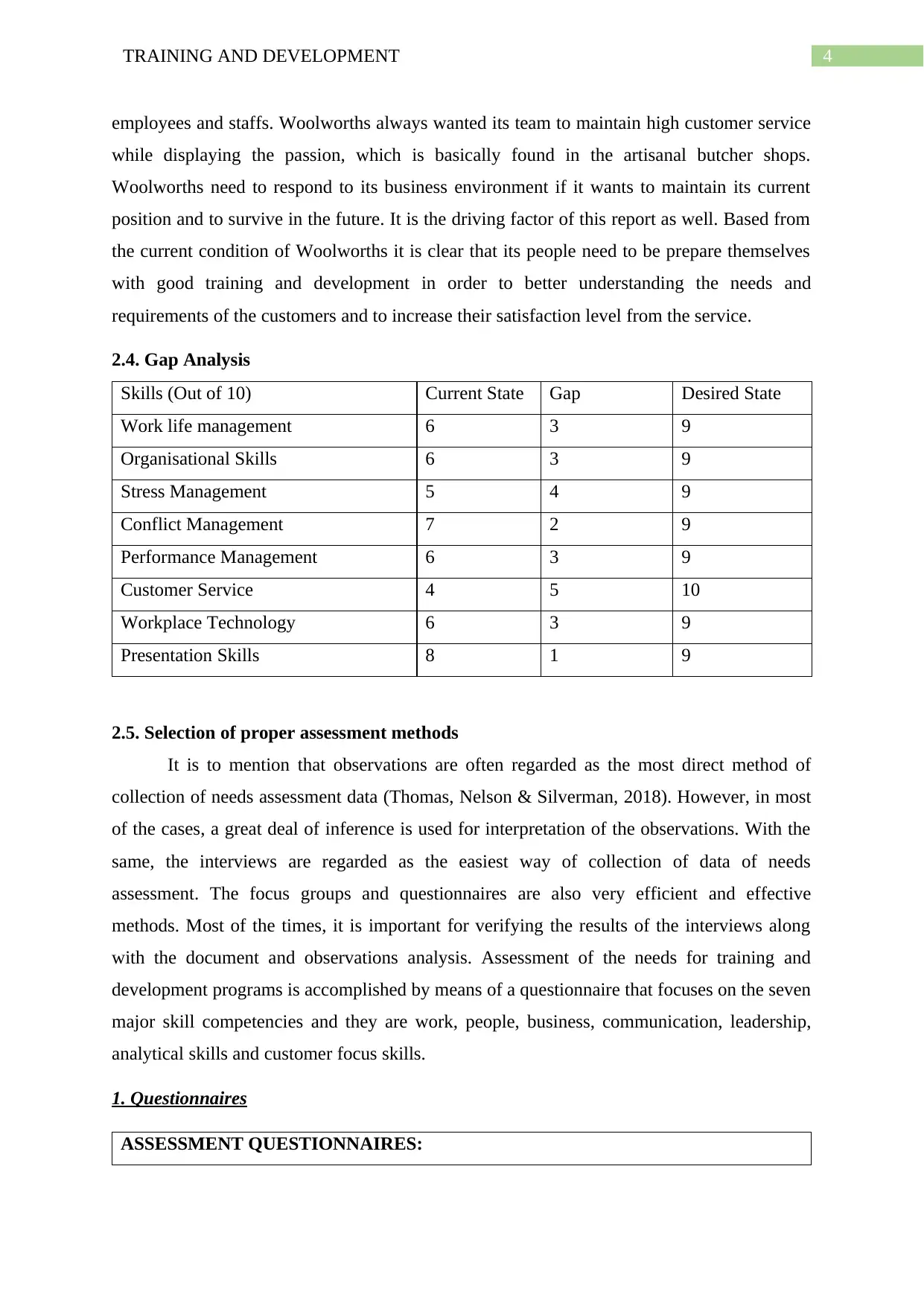
4TRAINING AND DEVELOPMENT
employees and staffs. Woolworths always wanted its team to maintain high customer service
while displaying the passion, which is basically found in the artisanal butcher shops.
Woolworths need to respond to its business environment if it wants to maintain its current
position and to survive in the future. It is the driving factor of this report as well. Based from
the current condition of Woolworths it is clear that its people need to be prepare themselves
with good training and development in order to better understanding the needs and
requirements of the customers and to increase their satisfaction level from the service.
2.4. Gap Analysis
Skills (Out of 10) Current State Gap Desired State
Work life management 6 3 9
Organisational Skills 6 3 9
Stress Management 5 4 9
Conflict Management 7 2 9
Performance Management 6 3 9
Customer Service 4 5 10
Workplace Technology 6 3 9
Presentation Skills 8 1 9
2.5. Selection of proper assessment methods
It is to mention that observations are often regarded as the most direct method of
collection of needs assessment data (Thomas, Nelson & Silverman, 2018). However, in most
of the cases, a great deal of inference is used for interpretation of the observations. With the
same, the interviews are regarded as the easiest way of collection of data of needs
assessment. The focus groups and questionnaires are also very efficient and effective
methods. Most of the times, it is important for verifying the results of the interviews along
with the document and observations analysis. Assessment of the needs for training and
development programs is accomplished by means of a questionnaire that focuses on the seven
major skill competencies and they are work, people, business, communication, leadership,
analytical skills and customer focus skills.
1. Questionnaires
ASSESSMENT QUESTIONNAIRES:
employees and staffs. Woolworths always wanted its team to maintain high customer service
while displaying the passion, which is basically found in the artisanal butcher shops.
Woolworths need to respond to its business environment if it wants to maintain its current
position and to survive in the future. It is the driving factor of this report as well. Based from
the current condition of Woolworths it is clear that its people need to be prepare themselves
with good training and development in order to better understanding the needs and
requirements of the customers and to increase their satisfaction level from the service.
2.4. Gap Analysis
Skills (Out of 10) Current State Gap Desired State
Work life management 6 3 9
Organisational Skills 6 3 9
Stress Management 5 4 9
Conflict Management 7 2 9
Performance Management 6 3 9
Customer Service 4 5 10
Workplace Technology 6 3 9
Presentation Skills 8 1 9
2.5. Selection of proper assessment methods
It is to mention that observations are often regarded as the most direct method of
collection of needs assessment data (Thomas, Nelson & Silverman, 2018). However, in most
of the cases, a great deal of inference is used for interpretation of the observations. With the
same, the interviews are regarded as the easiest way of collection of data of needs
assessment. The focus groups and questionnaires are also very efficient and effective
methods. Most of the times, it is important for verifying the results of the interviews along
with the document and observations analysis. Assessment of the needs for training and
development programs is accomplished by means of a questionnaire that focuses on the seven
major skill competencies and they are work, people, business, communication, leadership,
analytical skills and customer focus skills.
1. Questionnaires
ASSESSMENT QUESTIONNAIRES:
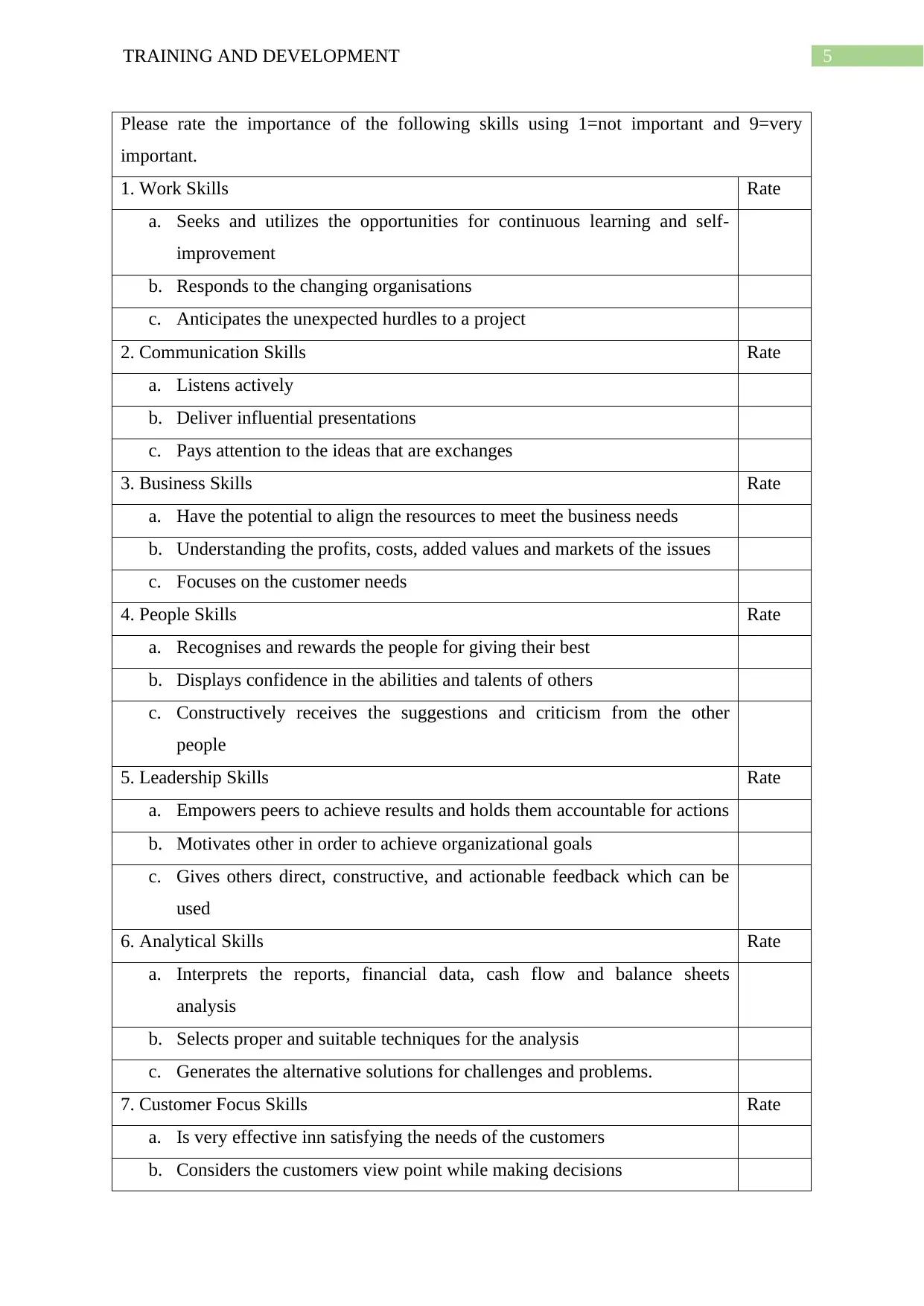
5TRAINING AND DEVELOPMENT
Please rate the importance of the following skills using 1=not important and 9=very
important.
1. Work Skills Rate
a. Seeks and utilizes the opportunities for continuous learning and self-
improvement
b. Responds to the changing organisations
c. Anticipates the unexpected hurdles to a project
2. Communication Skills Rate
a. Listens actively
b. Deliver influential presentations
c. Pays attention to the ideas that are exchanges
3. Business Skills Rate
a. Have the potential to align the resources to meet the business needs
b. Understanding the profits, costs, added values and markets of the issues
c. Focuses on the customer needs
4. People Skills Rate
a. Recognises and rewards the people for giving their best
b. Displays confidence in the abilities and talents of others
c. Constructively receives the suggestions and criticism from the other
people
5. Leadership Skills Rate
a. Empowers peers to achieve results and holds them accountable for actions
b. Motivates other in order to achieve organizational goals
c. Gives others direct, constructive, and actionable feedback which can be
used
6. Analytical Skills Rate
a. Interprets the reports, financial data, cash flow and balance sheets
analysis
b. Selects proper and suitable techniques for the analysis
c. Generates the alternative solutions for challenges and problems.
7. Customer Focus Skills Rate
a. Is very effective inn satisfying the needs of the customers
b. Considers the customers view point while making decisions
Please rate the importance of the following skills using 1=not important and 9=very
important.
1. Work Skills Rate
a. Seeks and utilizes the opportunities for continuous learning and self-
improvement
b. Responds to the changing organisations
c. Anticipates the unexpected hurdles to a project
2. Communication Skills Rate
a. Listens actively
b. Deliver influential presentations
c. Pays attention to the ideas that are exchanges
3. Business Skills Rate
a. Have the potential to align the resources to meet the business needs
b. Understanding the profits, costs, added values and markets of the issues
c. Focuses on the customer needs
4. People Skills Rate
a. Recognises and rewards the people for giving their best
b. Displays confidence in the abilities and talents of others
c. Constructively receives the suggestions and criticism from the other
people
5. Leadership Skills Rate
a. Empowers peers to achieve results and holds them accountable for actions
b. Motivates other in order to achieve organizational goals
c. Gives others direct, constructive, and actionable feedback which can be
used
6. Analytical Skills Rate
a. Interprets the reports, financial data, cash flow and balance sheets
analysis
b. Selects proper and suitable techniques for the analysis
c. Generates the alternative solutions for challenges and problems.
7. Customer Focus Skills Rate
a. Is very effective inn satisfying the needs of the customers
b. Considers the customers view point while making decisions
⊘ This is a preview!⊘
Do you want full access?
Subscribe today to unlock all pages.

Trusted by 1+ million students worldwide
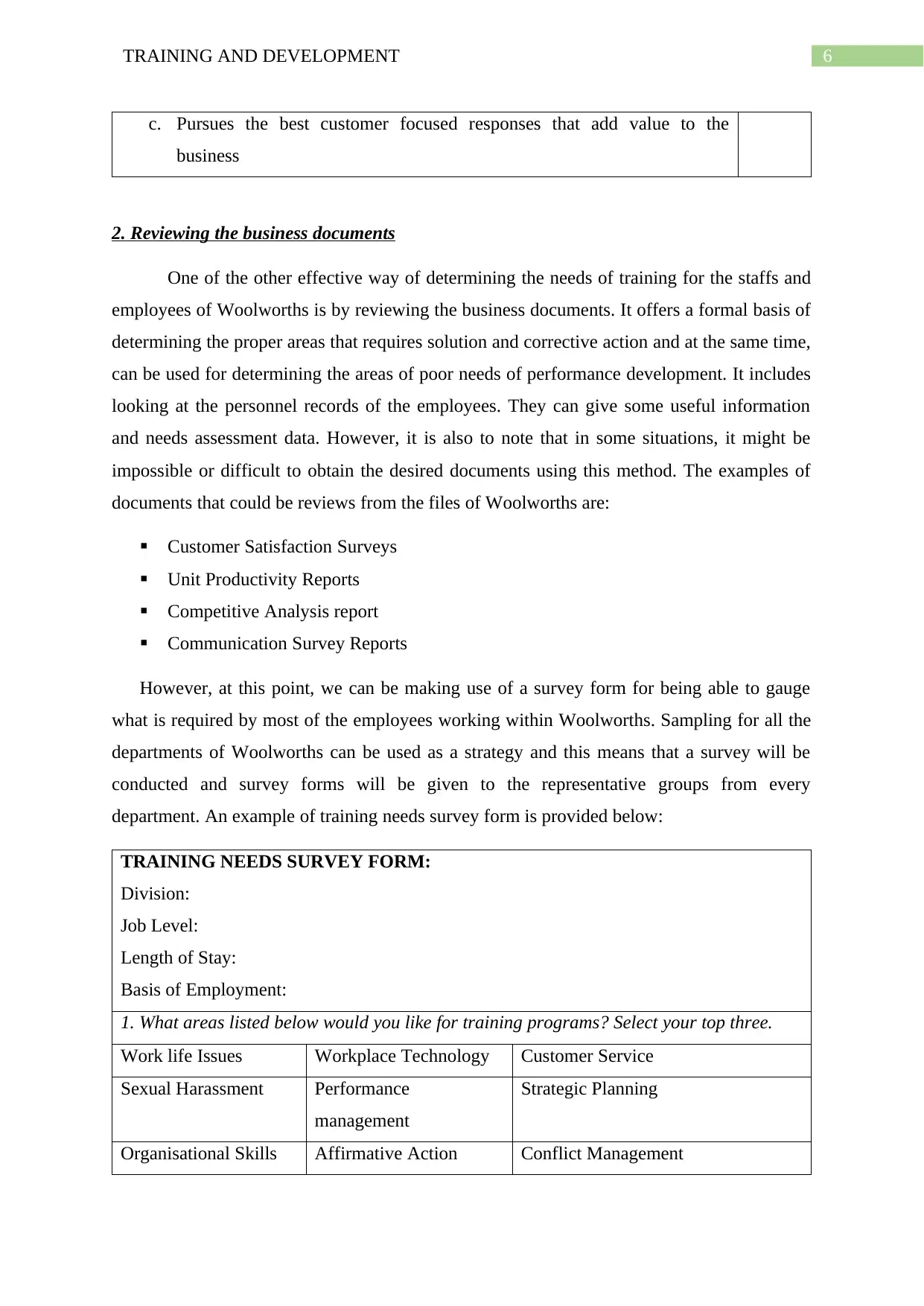
6TRAINING AND DEVELOPMENT
c. Pursues the best customer focused responses that add value to the
business
2. Reviewing the business documents
One of the other effective way of determining the needs of training for the staffs and
employees of Woolworths is by reviewing the business documents. It offers a formal basis of
determining the proper areas that requires solution and corrective action and at the same time,
can be used for determining the areas of poor needs of performance development. It includes
looking at the personnel records of the employees. They can give some useful information
and needs assessment data. However, it is also to note that in some situations, it might be
impossible or difficult to obtain the desired documents using this method. The examples of
documents that could be reviews from the files of Woolworths are:
Customer Satisfaction Surveys
Unit Productivity Reports
Competitive Analysis report
Communication Survey Reports
However, at this point, we can be making use of a survey form for being able to gauge
what is required by most of the employees working within Woolworths. Sampling for all the
departments of Woolworths can be used as a strategy and this means that a survey will be
conducted and survey forms will be given to the representative groups from every
department. An example of training needs survey form is provided below:
TRAINING NEEDS SURVEY FORM:
Division:
Job Level:
Length of Stay:
Basis of Employment:
1. What areas listed below would you like for training programs? Select your top three.
Work life Issues Workplace Technology Customer Service
Sexual Harassment Performance
management
Strategic Planning
Organisational Skills Affirmative Action Conflict Management
c. Pursues the best customer focused responses that add value to the
business
2. Reviewing the business documents
One of the other effective way of determining the needs of training for the staffs and
employees of Woolworths is by reviewing the business documents. It offers a formal basis of
determining the proper areas that requires solution and corrective action and at the same time,
can be used for determining the areas of poor needs of performance development. It includes
looking at the personnel records of the employees. They can give some useful information
and needs assessment data. However, it is also to note that in some situations, it might be
impossible or difficult to obtain the desired documents using this method. The examples of
documents that could be reviews from the files of Woolworths are:
Customer Satisfaction Surveys
Unit Productivity Reports
Competitive Analysis report
Communication Survey Reports
However, at this point, we can be making use of a survey form for being able to gauge
what is required by most of the employees working within Woolworths. Sampling for all the
departments of Woolworths can be used as a strategy and this means that a survey will be
conducted and survey forms will be given to the representative groups from every
department. An example of training needs survey form is provided below:
TRAINING NEEDS SURVEY FORM:
Division:
Job Level:
Length of Stay:
Basis of Employment:
1. What areas listed below would you like for training programs? Select your top three.
Work life Issues Workplace Technology Customer Service
Sexual Harassment Performance
management
Strategic Planning
Organisational Skills Affirmative Action Conflict Management
Paraphrase This Document
Need a fresh take? Get an instant paraphrase of this document with our AI Paraphraser
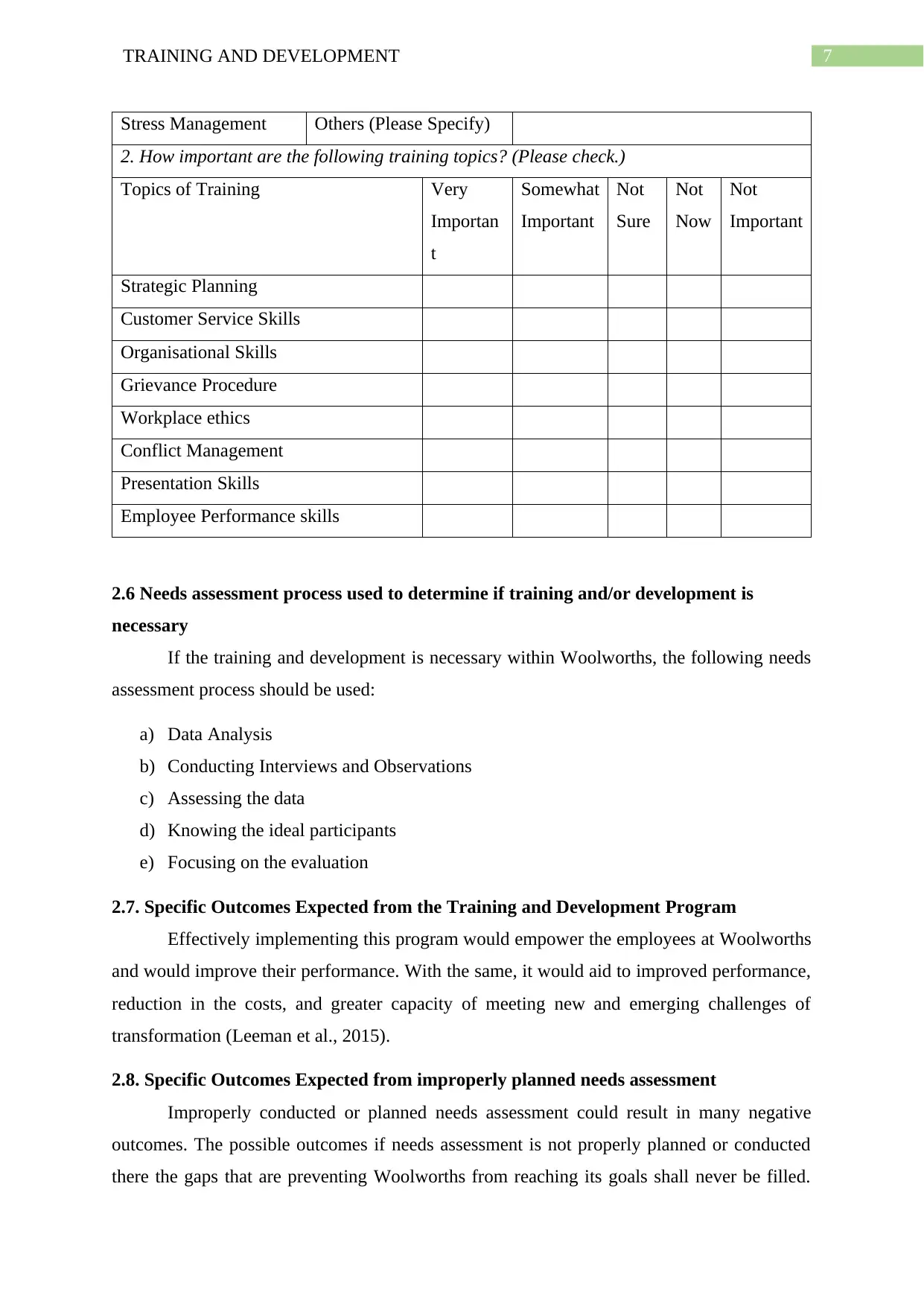
7TRAINING AND DEVELOPMENT
Stress Management Others (Please Specify)
2. How important are the following training topics? (Please check.)
Topics of Training Very
Importan
t
Somewhat
Important
Not
Sure
Not
Now
Not
Important
Strategic Planning
Customer Service Skills
Organisational Skills
Grievance Procedure
Workplace ethics
Conflict Management
Presentation Skills
Employee Performance skills
2.6 Needs assessment process used to determine if training and/or development is
necessary
If the training and development is necessary within Woolworths, the following needs
assessment process should be used:
a) Data Analysis
b) Conducting Interviews and Observations
c) Assessing the data
d) Knowing the ideal participants
e) Focusing on the evaluation
2.7. Specific Outcomes Expected from the Training and Development Program
Effectively implementing this program would empower the employees at Woolworths
and would improve their performance. With the same, it would aid to improved performance,
reduction in the costs, and greater capacity of meeting new and emerging challenges of
transformation (Leeman et al., 2015).
2.8. Specific Outcomes Expected from improperly planned needs assessment
Improperly conducted or planned needs assessment could result in many negative
outcomes. The possible outcomes if needs assessment is not properly planned or conducted
there the gaps that are preventing Woolworths from reaching its goals shall never be filled.
Stress Management Others (Please Specify)
2. How important are the following training topics? (Please check.)
Topics of Training Very
Importan
t
Somewhat
Important
Not
Sure
Not
Now
Not
Important
Strategic Planning
Customer Service Skills
Organisational Skills
Grievance Procedure
Workplace ethics
Conflict Management
Presentation Skills
Employee Performance skills
2.6 Needs assessment process used to determine if training and/or development is
necessary
If the training and development is necessary within Woolworths, the following needs
assessment process should be used:
a) Data Analysis
b) Conducting Interviews and Observations
c) Assessing the data
d) Knowing the ideal participants
e) Focusing on the evaluation
2.7. Specific Outcomes Expected from the Training and Development Program
Effectively implementing this program would empower the employees at Woolworths
and would improve their performance. With the same, it would aid to improved performance,
reduction in the costs, and greater capacity of meeting new and emerging challenges of
transformation (Leeman et al., 2015).
2.8. Specific Outcomes Expected from improperly planned needs assessment
Improperly conducted or planned needs assessment could result in many negative
outcomes. The possible outcomes if needs assessment is not properly planned or conducted
there the gaps that are preventing Woolworths from reaching its goals shall never be filled.
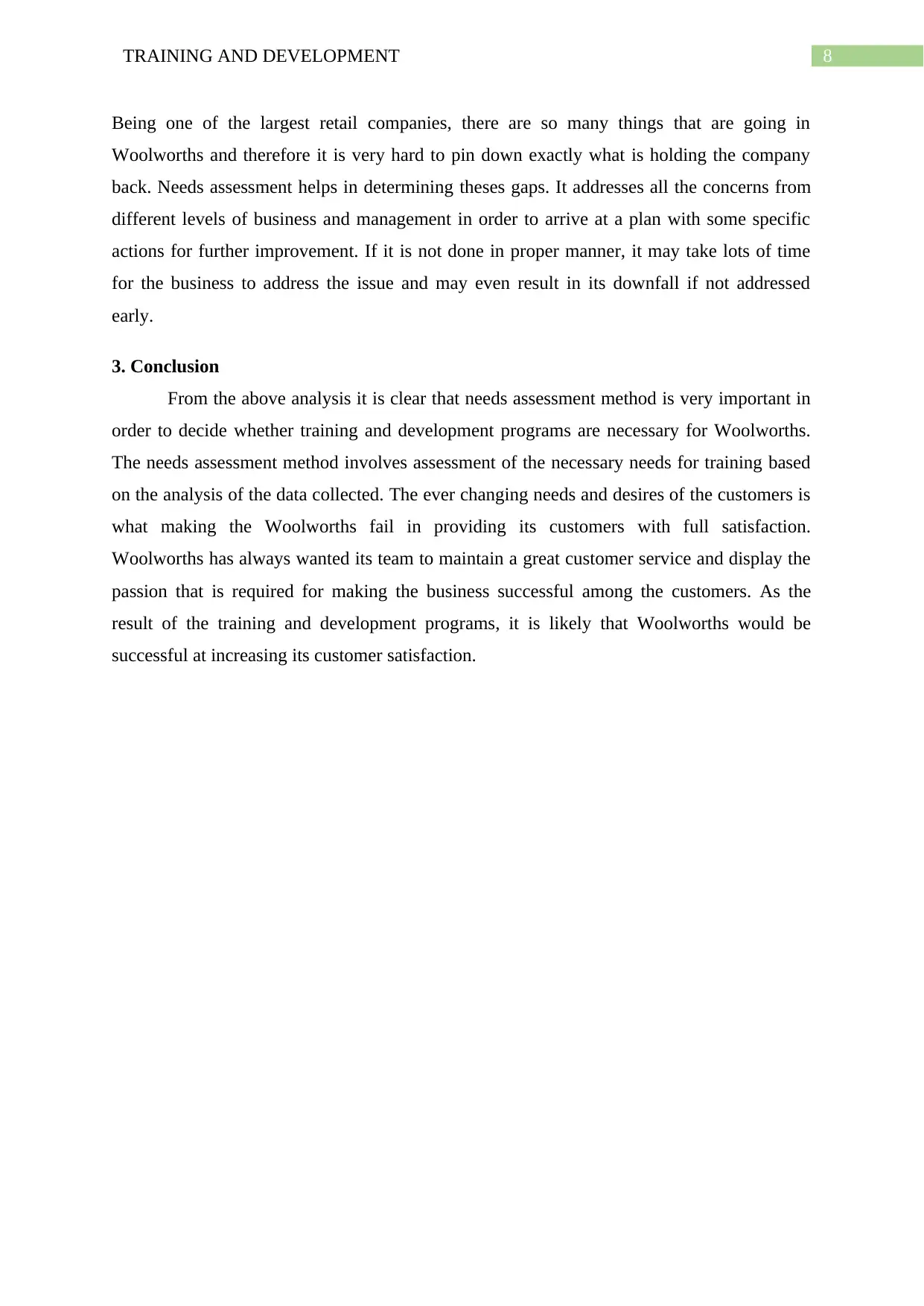
8TRAINING AND DEVELOPMENT
Being one of the largest retail companies, there are so many things that are going in
Woolworths and therefore it is very hard to pin down exactly what is holding the company
back. Needs assessment helps in determining theses gaps. It addresses all the concerns from
different levels of business and management in order to arrive at a plan with some specific
actions for further improvement. If it is not done in proper manner, it may take lots of time
for the business to address the issue and may even result in its downfall if not addressed
early.
3. Conclusion
From the above analysis it is clear that needs assessment method is very important in
order to decide whether training and development programs are necessary for Woolworths.
The needs assessment method involves assessment of the necessary needs for training based
on the analysis of the data collected. The ever changing needs and desires of the customers is
what making the Woolworths fail in providing its customers with full satisfaction.
Woolworths has always wanted its team to maintain a great customer service and display the
passion that is required for making the business successful among the customers. As the
result of the training and development programs, it is likely that Woolworths would be
successful at increasing its customer satisfaction.
Being one of the largest retail companies, there are so many things that are going in
Woolworths and therefore it is very hard to pin down exactly what is holding the company
back. Needs assessment helps in determining theses gaps. It addresses all the concerns from
different levels of business and management in order to arrive at a plan with some specific
actions for further improvement. If it is not done in proper manner, it may take lots of time
for the business to address the issue and may even result in its downfall if not addressed
early.
3. Conclusion
From the above analysis it is clear that needs assessment method is very important in
order to decide whether training and development programs are necessary for Woolworths.
The needs assessment method involves assessment of the necessary needs for training based
on the analysis of the data collected. The ever changing needs and desires of the customers is
what making the Woolworths fail in providing its customers with full satisfaction.
Woolworths has always wanted its team to maintain a great customer service and display the
passion that is required for making the business successful among the customers. As the
result of the training and development programs, it is likely that Woolworths would be
successful at increasing its customer satisfaction.
⊘ This is a preview!⊘
Do you want full access?
Subscribe today to unlock all pages.

Trusted by 1+ million students worldwide
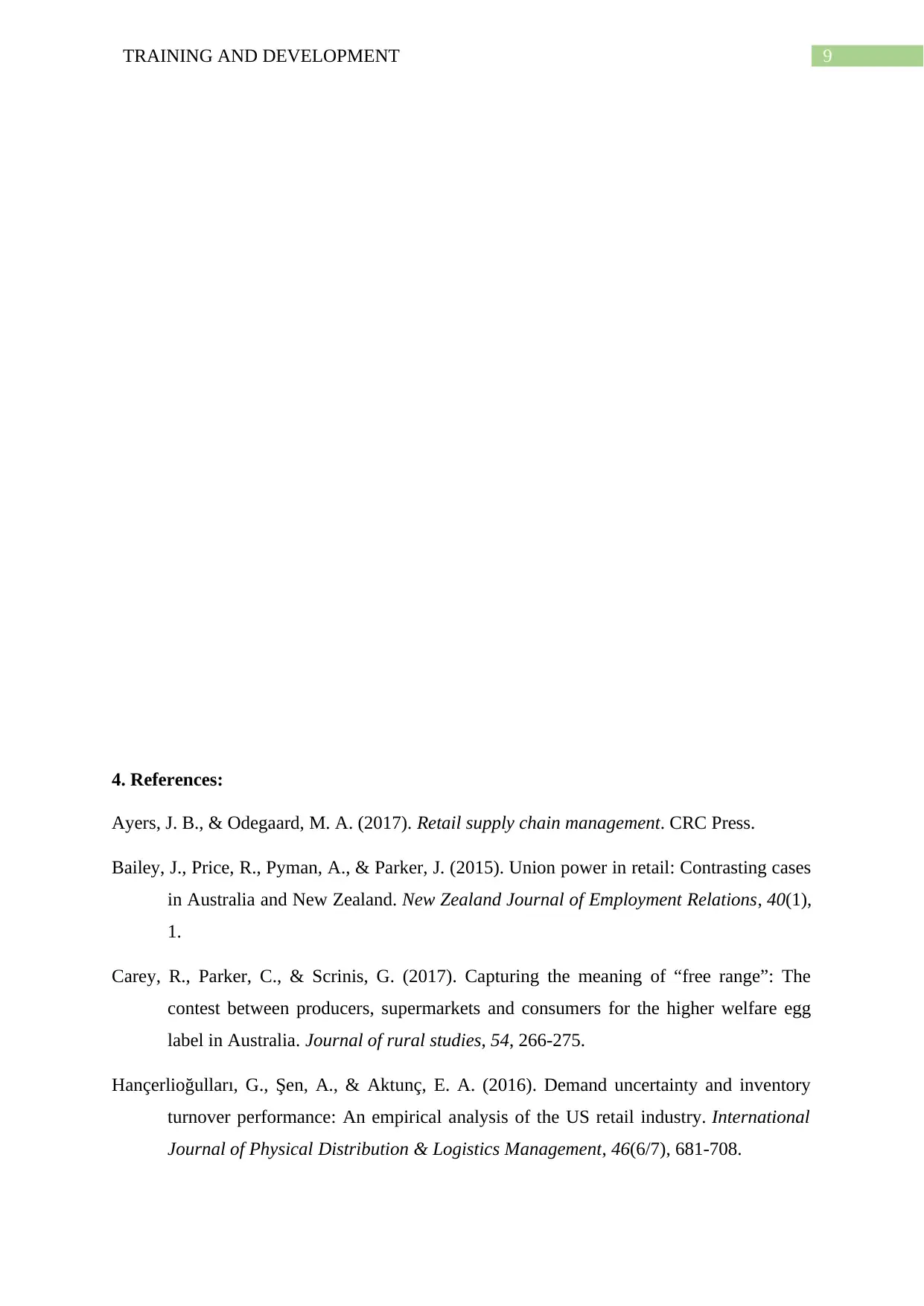
9TRAINING AND DEVELOPMENT
4. References:
Ayers, J. B., & Odegaard, M. A. (2017). Retail supply chain management. CRC Press.
Bailey, J., Price, R., Pyman, A., & Parker, J. (2015). Union power in retail: Contrasting cases
in Australia and New Zealand. New Zealand Journal of Employment Relations, 40(1),
1.
Carey, R., Parker, C., & Scrinis, G. (2017). Capturing the meaning of “free range”: The
contest between producers, supermarkets and consumers for the higher welfare egg
label in Australia. Journal of rural studies, 54, 266-275.
Hançerlioğulları, G., Şen, A., & Aktunç, E. A. (2016). Demand uncertainty and inventory
turnover performance: An empirical analysis of the US retail industry. International
Journal of Physical Distribution & Logistics Management, 46(6/7), 681-708.
4. References:
Ayers, J. B., & Odegaard, M. A. (2017). Retail supply chain management. CRC Press.
Bailey, J., Price, R., Pyman, A., & Parker, J. (2015). Union power in retail: Contrasting cases
in Australia and New Zealand. New Zealand Journal of Employment Relations, 40(1),
1.
Carey, R., Parker, C., & Scrinis, G. (2017). Capturing the meaning of “free range”: The
contest between producers, supermarkets and consumers for the higher welfare egg
label in Australia. Journal of rural studies, 54, 266-275.
Hançerlioğulları, G., Şen, A., & Aktunç, E. A. (2016). Demand uncertainty and inventory
turnover performance: An empirical analysis of the US retail industry. International
Journal of Physical Distribution & Logistics Management, 46(6/7), 681-708.
Paraphrase This Document
Need a fresh take? Get an instant paraphrase of this document with our AI Paraphraser
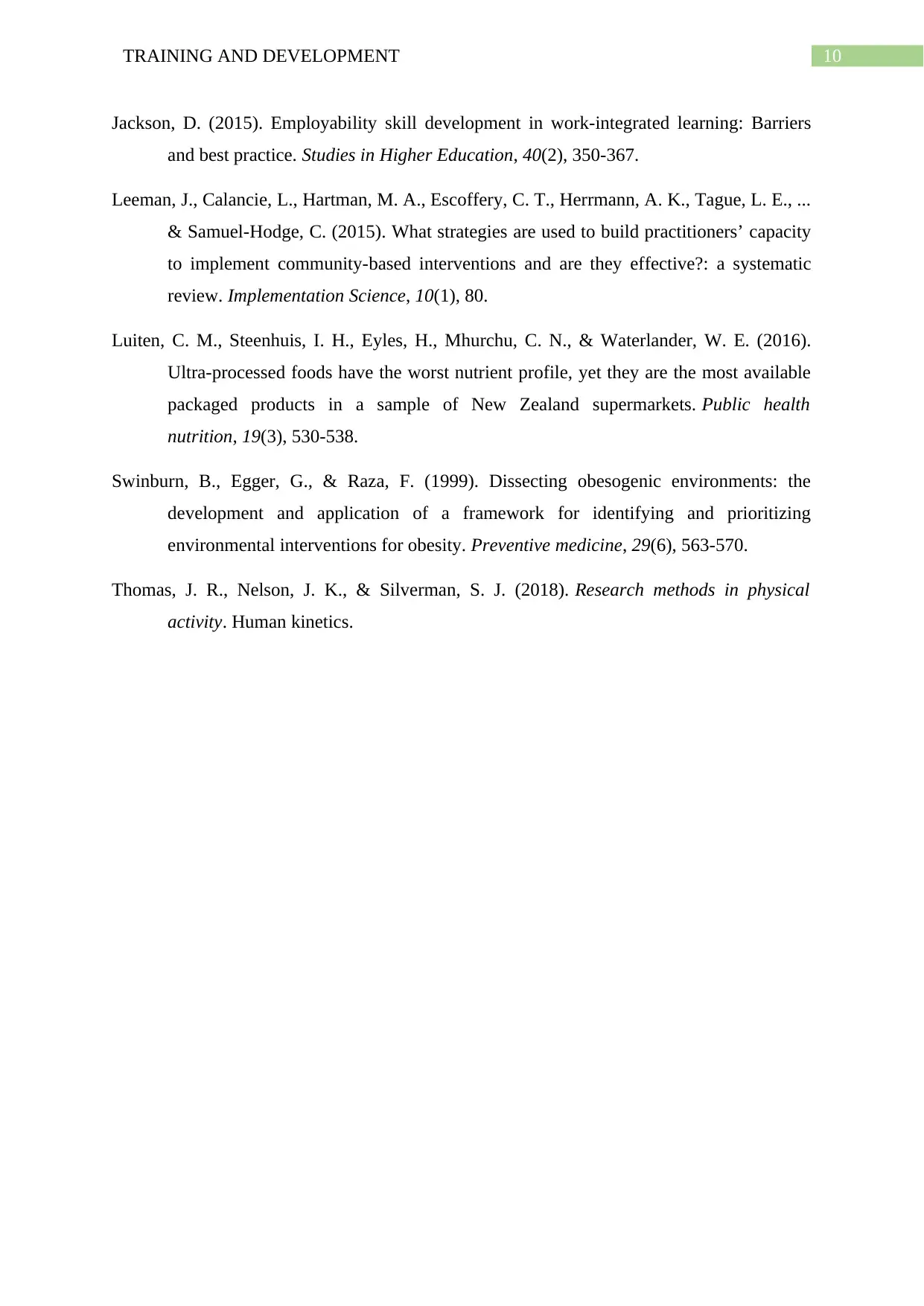
10TRAINING AND DEVELOPMENT
Jackson, D. (2015). Employability skill development in work-integrated learning: Barriers
and best practice. Studies in Higher Education, 40(2), 350-367.
Leeman, J., Calancie, L., Hartman, M. A., Escoffery, C. T., Herrmann, A. K., Tague, L. E., ...
& Samuel-Hodge, C. (2015). What strategies are used to build practitioners’ capacity
to implement community-based interventions and are they effective?: a systematic
review. Implementation Science, 10(1), 80.
Luiten, C. M., Steenhuis, I. H., Eyles, H., Mhurchu, C. N., & Waterlander, W. E. (2016).
Ultra-processed foods have the worst nutrient profile, yet they are the most available
packaged products in a sample of New Zealand supermarkets. Public health
nutrition, 19(3), 530-538.
Swinburn, B., Egger, G., & Raza, F. (1999). Dissecting obesogenic environments: the
development and application of a framework for identifying and prioritizing
environmental interventions for obesity. Preventive medicine, 29(6), 563-570.
Thomas, J. R., Nelson, J. K., & Silverman, S. J. (2018). Research methods in physical
activity. Human kinetics.
Jackson, D. (2015). Employability skill development in work-integrated learning: Barriers
and best practice. Studies in Higher Education, 40(2), 350-367.
Leeman, J., Calancie, L., Hartman, M. A., Escoffery, C. T., Herrmann, A. K., Tague, L. E., ...
& Samuel-Hodge, C. (2015). What strategies are used to build practitioners’ capacity
to implement community-based interventions and are they effective?: a systematic
review. Implementation Science, 10(1), 80.
Luiten, C. M., Steenhuis, I. H., Eyles, H., Mhurchu, C. N., & Waterlander, W. E. (2016).
Ultra-processed foods have the worst nutrient profile, yet they are the most available
packaged products in a sample of New Zealand supermarkets. Public health
nutrition, 19(3), 530-538.
Swinburn, B., Egger, G., & Raza, F. (1999). Dissecting obesogenic environments: the
development and application of a framework for identifying and prioritizing
environmental interventions for obesity. Preventive medicine, 29(6), 563-570.
Thomas, J. R., Nelson, J. K., & Silverman, S. J. (2018). Research methods in physical
activity. Human kinetics.
1 out of 11
Related Documents
Your All-in-One AI-Powered Toolkit for Academic Success.
+13062052269
info@desklib.com
Available 24*7 on WhatsApp / Email
![[object Object]](/_next/static/media/star-bottom.7253800d.svg)
Unlock your academic potential
Copyright © 2020–2025 A2Z Services. All Rights Reserved. Developed and managed by ZUCOL.





